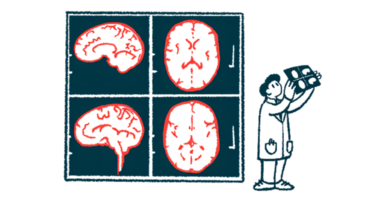Swallowing difficulties pose great risks for Duopa-treated patients
Dysphagia raises risk of death in people with advanced Parkinson's, study finds

Dysphagia, or swallowing difficulties, is associated with a higher risk of death among people with advanced Parkinson’s disease who are treated with Duodopa/Duopa, a levodopa/carbidopa intestinal gel (LCIG), a study shows.
Notably, “dysphagia was the only significant predictor of death in our cohort [group], confirming and highlighting the relevance and impact of this symptom in the advanced disease phases also in a cohort of patients treated with LCIG,” researchers wrote.
The study, “The impact of dysphagia in Parkinson’s disease patients treated with levodopa/carbidopa intestinal gel,” was published in Parkinsonism and Related Disorders.
Swallowing difficulties can result in aspiration pneumonia
Dysphagia, or difficulties in swallowing liquids, food, and medication, is a common symptom of Parkinson’s, affecting up to 80% of patients over the course of the disease. It can reduce quality of life and lead to dehydration and malnutrition, being “strongly associated with dementia, hallucinations, and falls,” the researchers wrote.
In addition, aspiration pneumonia — a lung infection associated with food or liquid being aspirated into the airways — is a severe complication of dysphagia, being the leading cause of death in Parkinson’s patients.
“A recent nationwide study estimated that about two-thirds of PD [Parkinson’s disease] patients die within a year since an episode of aspiration pneumonia, which is in turn due to dysphagia in most cases,” the researchers wrote.
However, long-term studies of dysphagia’s impact in people with advanced Parkinson’s, especially in those treated with AbbVie’s Duodopa/Duopa, are still lacking.
Duopa is a long-term, gel-based therapy approved in the U.S. and Europe — where it’s marketed as Duodopa — to reduce motor fluctuations in advanced Parkinson’s. It delivers a combination of levodopa and carbidopa directly into the small intestine through a PEG-J tube surgically inserted in the abdomen.
Levodopa is the precursor of dopamine, the major brain chemical messenger that’s progressively lost in Parkinson’s, and carbidopa works by preventing the levodopa-dopamine conversion before reaching the brain.
We hope this study can raise attention to this severe and dangerous [Parkinson’s disease] symptom, suggesting an accurate screening, especially in frail populations like those of [Parkinson’s] patients treated with device-aided therapies.
Study included 86 patients treated with Duopa/Duodopa for at least 6 months
By bypassing the stomach, Duopa/Duodopa is expected to be more quickly absorbed into the bloodstream, increasing the levels of levodopa that reach the brain and are then converted into dopamine.
Also, “the possibility of using the already positioned PEG tube for feeding in PD patients treated with LCIG represents a possible advantage for the management of dysphagia and prevention of its complications,” the researchers wrote.
Now, a team of researchers in Italy retrospectively analyzed data from 86 Parkinson’s patients (58 men and 28 women) treated with Duopa/Duodopa for at least six months to investigate the impact of dysphagia on their mortality.
At treatment start, patients were a mean age of 67.7 years, with a disease duration of 13 years, and mild to moderate disability, as assessed with the Hoehn and Yahr scale. None was experiencing dysphagia.
A total of 42 patients (48.8%) developed dysphagia during a mean follow-up of three years. Nevertheless, the researchers found no significant difference in age, disease duration, sex, and Hoehn and Yahr score at the therapy’s start between patients who developed dysphagia and those who did not.
A survival analysis showed a significantly higher mortality rate in the treated patients with dysphagia than in those without this complication. When considering factors that may affect survival, such as age, disease duration, disease-associated disability at treatment start, and dysphagia development, the team found that dysphagia was the only significant predictor of increased mortality.
Specifically, patients with dysphagia were seven times more likely to die during follow-up than those who did not develop it.
Dysphagia linked to dementia, hallucinations, and disability
The researchers also evaluated potential links between dysphagia and other variables, such as age, disease duration, disability, presence of hallucinations, and dementia. They found that dysphagia was significantly associated with dementia, hallucinations, and disability, as assessed with the Hoehn and Yahr scale.
However, when analyzing each as an independent outcome, only the Hoehn and Yarh score was significantly linked to the presence of dysphagia, “indicating the important role of motor disease progression in the development of dysphagia and independently from other non-motor symptoms,” the researchers wrote.
Overall, “we explored for the first time the impact of dysphagia on mortality in a large cohort of advanced PD patients treated with LCIG, confirming its pivotal role as a risk factor for death, which resulted partly unrelated to other PD disabilities milestones,” the researchers wrote.
These findings emphasize the importance of managing dysphagia in the advanced stages of Parkinson’s, the team noted, considering that patients treated with Duopa/Duodopa have a PEG-J tube, which can be used also for feeding, preserving the airway when dysphagia worsens.
Nonetheless, “we hope this study can raise attention to this severe and dangerous PD symptom, suggesting an accurate screening, especially in frail populations like those of PD patients treated with device-aided therapies,” the researchers concluded.








